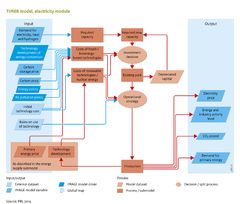Energy conversion/Description: Difference between revisions
Jump to navigation
Jump to search
No edit summary |
Oostenrijr (talk | contribs) m (Text replacement - "Koberle et al., 2015" to "Köberle et al., 2015") |
||
| Line 1: | Line 1: | ||
{{ComponentDescriptionTemplate | {{ComponentDescriptionTemplate | ||
|Reference=Hoogwijk, 2004; Van Vuuren, 2007; Hendriks et al., 2004b; Van Ruijven et al., 2007; Ueckerdt et al., 2016; Gernaat et al., 2014; | |Reference=Hoogwijk, 2004; Van Vuuren, 2007; Hendriks et al., 2004b; Van Ruijven et al., 2007; Ueckerdt et al., 2016; Gernaat et al., 2014; Köberle et al., 2015; De Boer and Van Vuuren, under review; | ||
|Description=[[TIMER model|TIMER]] includes two main energy conversion modules: Electric power generation and hydrogen generation. Below, electric power generation is described in detail. In addition, the key characteristics of the hydrogen generation model, which follows a similar structure, are presented. | |Description=[[TIMER model|TIMER]] includes two main energy conversion modules: Electric power generation and hydrogen generation. Below, electric power generation is described in detail. In addition, the key characteristics of the hydrogen generation model, which follows a similar structure, are presented. | ||
| Line 36: | Line 36: | ||
* Backup costs have been added to represent the additional costs required in order to meet the capacity and energy production requirements of a load band. Backup costs are higher for technologies with low capacity credits. Backup costs include all standard cost components for the chosen backup technology. | * Backup costs have been added to represent the additional costs required in order to meet the capacity and energy production requirements of a load band. Backup costs are higher for technologies with low capacity credits. Backup costs include all standard cost components for the chosen backup technology. | ||
* Curtailment costs are only relevant for VRE technologies and CHP. Curtailments occur when the supply exceeds the demand. The degree to which curtailment occurs depends on VRE share, storage use and the regional correlation between electricity demand and VRE or CHP supply. Curtailment influences the LCOE by reducing the potential amount of electricity that could be generated. | * Curtailment costs are only relevant for VRE technologies and CHP. Curtailments occur when the supply exceeds the demand. The degree to which curtailment occurs depends on VRE share, storage use and the regional correlation between electricity demand and VRE or CHP supply. Curtailment influences the LCOE by reducing the potential amount of electricity that could be generated. | ||
* Load factor reduction results from the utilisation of VRE sites with less favourable environmental conditions, such as lower wind speeds or less solar irradiation. This results in a lower potential load influencing the LCOE by reducing the potential electricity generation. The development of load factor reduction is captured in cost supply curves. For more information on the TIMER cost supply curves see: Hoogwijk ([[Hoogwijk, 2004|2004]]), Gernaat et al., ([[Gernaat et al., 2014|2014]]) and Koberle et al., ([[ | * Load factor reduction results from the utilisation of VRE sites with less favourable environmental conditions, such as lower wind speeds or less solar irradiation. This results in a lower potential load influencing the LCOE by reducing the potential electricity generation. The development of load factor reduction is captured in cost supply curves. For more information on the TIMER cost supply curves see: Hoogwijk ([[Hoogwijk, 2004|2004]]), Gernaat et al., ([[Gernaat et al., 2014|2014]]) and Koberle et al., ([[Köberle et al., 2015|2015]]). | ||
* Storage use has been optimised in the RLDC data set. For more information on storage use, see Ueckerdt et al. (n.d.). | * Storage use has been optimised in the RLDC data set. For more information on storage use, see Ueckerdt et al. (n.d.). | ||
* Transmission and distribution costs are simulated by adding a fixed relationship between the amount of capacity and the required amount of transmission and distribution capital. VRE cost supply curves contain additional transmission costs resulting from distance between VRE potential and demand centres. | * Transmission and distribution costs are simulated by adding a fixed relationship between the amount of capacity and the required amount of transmission and distribution capital. VRE cost supply curves contain additional transmission costs resulting from distance between VRE potential and demand centres. | ||
Revision as of 08:32, 13 June 2017
Parts of Energy conversion/Description
| Component is implemented in: |
|
| Related IMAGE components |
| Projects/Applications |
| Models/Databases |
| Key publications |
| References |
